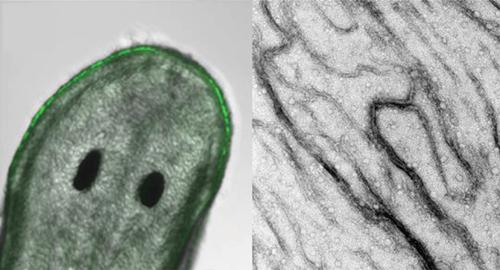当前位置:
X-MOL 学术
›
Protein Pept. Lett.
›
论文详情
Our official English website, www.x-mol.net, welcomes your
feedback! (Note: you will need to create a separate account there.)
Characterization of an Intermediate Filament Protein from the Platyhelminth, Dugesia japonica.
Protein & Peptide Letters ( IF 1.0 ) Pub Date : 2020-05-01 , DOI: 10.2174/0929866526666191025102902 Akiko Yamamoto 1 , Ken-Ichiro Matsunaga 1 , Toyoaki Anai 2 , Hitoshi Kawano 1 , Toshihisa Ueda 2 , Toshihiko Matsumoto 3 , Shoji Ando 1, 3
中文翻译:

侧柏,豚鼠(Dugesia japonica)中间丝蛋白的表征。
更新日期:2020-05-01
Protein & Peptide Letters ( IF 1.0 ) Pub Date : 2020-05-01 , DOI: 10.2174/0929866526666191025102902 Akiko Yamamoto 1 , Ken-Ichiro Matsunaga 1 , Toyoaki Anai 2 , Hitoshi Kawano 1 , Toshihisa Ueda 2 , Toshihiko Matsumoto 3 , Shoji Ando 1, 3
Affiliation

|
Background: Intermediate Filaments (IFs) are major constituents of the cytoskeletal systems in animal cells.
Objective: To gain insights into the structure-function relationship of invertebrate cytoplasmic IF proteins, we characterized an IF protein from the platyhelminth, Dugesia japonica, termed Dif-1. Methods: cDNA cloning, in situ hybridization, immunohistochemical analysis, and IF assembly experiments in vitro using recombinant Dif-1, were performed for protein characterization. Results: The structure deduced from the cDNA sequence showed that Djf-1 comprises 568 amino acids and has a tripartite domain structure (N-terminal head, central rod, and C-terminal tail) that is characteristic of IF proteins. Similar to nuclear IF lamins, Djf-1 contains an extra 42 residues in the coil 1b subdomain of the rod domain that is absent from vertebrate cytoplasmic IF proteins and a nuclear lamin-homology segment of approximately 105 residues in the tail domain; however, it contains no nuclear localization signal. In situ hybridization analysis showed that Djf-1 mRNA is specifically expressed in cells located within the marginal region encircling the worm body. Immunohistochemical analysis showed that Djf-1 protein forms cytoplasmic IFs located close to the microvilli of the cells. In vitro IF assembly experiments using recombinant proteins showed that Djf-1 alone polymerizes into IFs. Deletion of the extra 42 residues in the coil 1b subdomain resulted in the failure of IF formation. Conclusion: Together with data from other histological studies, our results suggest that Djf- 1 is expressed specifically in anchor cells within the glandular adhesive organs of the worm and that Djf-1 IFs may play a role in protecting the cells from mechanical stress.中文翻译:

侧柏,豚鼠(Dugesia japonica)中间丝蛋白的表征。
背景:中间丝(IFs)是动物细胞中细胞骨架系统的主要成分。
目的:为了深入了解无脊椎动物胞质IF蛋白的结构与功能之间的关系,我们鉴定了来自鸭嘴虫(Dugesia japonica)的蠕虫中的IF蛋白,称为Dif-1。 方法:利用重组Dif-1在体外进行cDNA克隆,原位杂交,免疫组织化学分析和IF组装实验,以进行蛋白质表征。 结果:从cDNA序列推导的结构表明Djf-1包含568个氨基酸,并具有IF蛋白特征的三重结构域结构(N末端头部,中心杆和C末端尾部)。与核IF核纤层蛋白相似,Djf-1在杆状结构域的线圈1b子域中包含额外的42个残基,而脊椎动物胞质IF蛋白中不存在此残基,而在尾部域中约有105个残基的核纤层同源性片段。但是,它不包含核定位信号。原位杂交分析表明Djf-1 mRNA在蠕虫体边缘区域的细胞中特异性表达。免疫组织化学分析表明,Djf-1蛋白形成了位于细胞微绒毛附近的胞质IF。使用重组蛋白的体外IF组装实验表明,Djf-1单独聚合成IF。线圈1b子域中多余的42个残基的删除导致IF形成失败。 结论:结合其他组织学研究的数据,我们的结果表明Djf-1在蠕虫的腺体粘附器官内的锚定细胞中特异性表达,并且Djf-1 IF可能在保护细胞免受机械应力的作用中发挥作用。










































 京公网安备 11010802027423号
京公网安备 11010802027423号